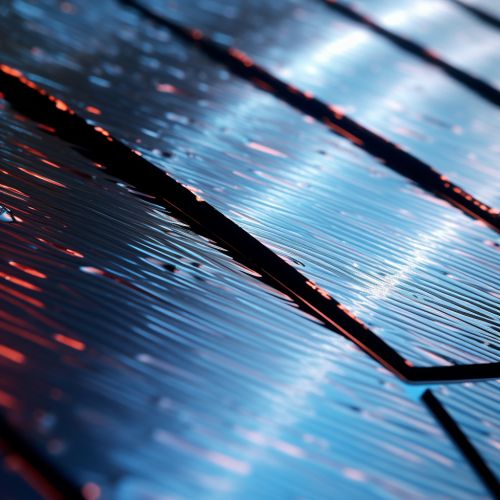Polycrystalline solar cell
Introduction
A Polycrystalline solar cell or multicrystalline solar cell is a type of Photovoltaic cell that is manufactured using polycrystalline silicon. Polycrystalline silicon, also known as polysilicon or poly-Si, is a high purity, polycrystalline form of silicon, used as a raw material by the solar photovoltaic and electronics industry.


Production Process
The production of polycrystalline solar cells involves several steps. The first step is the production of silicon, which is the primary raw material used in the production of solar cells. The silicon is then purified and formed into a large block, known as a silicon ingot. This ingot is then sliced into thin wafers, which are then processed into solar cells.
Structure and Operation
Polycrystalline solar cells are made up of many small silicon crystals, hence the name 'polycrystalline'. Each crystal in the cell is oriented in a different direction, which gives the cell its characteristic grainy appearance. When light strikes the surface of the cell, it is absorbed by the silicon crystals, which then generate electricity.
Efficiency and Performance
The efficiency of a polycrystalline solar cell is typically lower than that of a monocrystalline solar cell. This is due to the fact that the light absorption and electrical generation processes in a polycrystalline cell are less efficient, due to the presence of many crystal boundaries. However, polycrystalline cells are cheaper to produce, which makes them a popular choice for many applications.
Applications
Polycrystalline solar cells are used in a wide range of applications, from small-scale residential installations to large-scale commercial and utility-scale solar power plants. They are also used in off-grid applications, such as in remote areas where access to the electricity grid is not available.
Advantages and Disadvantages
The main advantage of polycrystalline solar cells is their lower cost compared to monocrystalline cells. They are also easier to produce, which makes them more readily available. However, their lower efficiency means that they require more space to produce the same amount of electricity as a monocrystalline cell.
Future Developments
Research is ongoing to improve the efficiency and performance of polycrystalline solar cells. One area of focus is the development of new materials and manufacturing processes that can reduce the number of crystal boundaries in the cell, thereby increasing its efficiency.
